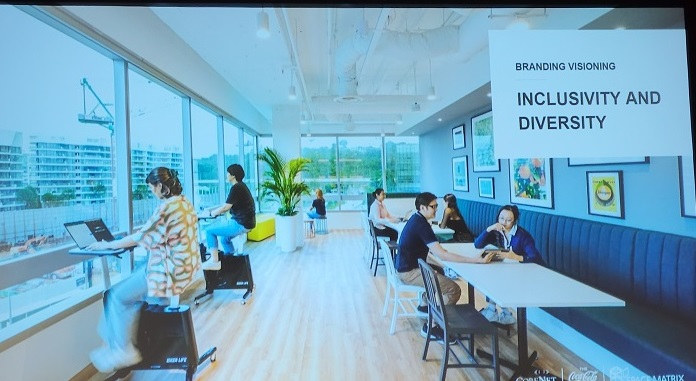When creating the future of work within an organization, workplace strategists and leaders have no shortage of tasks and obstacles they need to address. Not only are workplace leaders responsible for designing the physical office spaces to support hybrid work, but they also have to ensure the workplace provides an experience that makes employees feel connected to the larger organization. In short, workplace leaders today need to defend the physical office and its benefits by telling its story in a way that will excite employees and make them want to come into the office.
The Need for a Better Workplace Story
The need to tell a better workplace story is just one challenge for enterprise leaders,
Kay Sargent, senior principal and director of workplace for HOK, said during a panel discussion at
the CoreNet Global Summit earlier this month. Sargent also shared her thoughts on obstacles including the erosion of social capital and uneven hybrid work policies that create HR issues. Despite all the changes we’ve seen in the office in the past several years, Sargent argued that now is the time for leadership to really step up and talk differently about today’s workplace.
"Part of the problem is we're not telling a good story,” said Sargent, who used an analogy to encourage the audience to highlight the potential down sides of remote work: “We're not telling people the consequences of eating chocolate for dinner every night — because there is one — and [similarly] we're not telling them the benefit of coming to the workplace," Sargent said. "So, as we go forward, there's some shifts that we need to make; we really need to think about the purpose of place."
A crucial part of telling a better workplace story is finding ways to “help people connect and bond and build back social capital” in the workplace, Sargent said. When employees who have been in the workforce for a while started working from home during the pandemic, they had a lot of social capital built up, Sargent explained. However, younger employees, who don’t have professional networks, are now finding that remote work isn’t quite working out, Sargent added.
Additionally, telling a better workplace story will require rethinking how workplace leaders design spaces for their employees. “For the last several years, decades really, we've designed workspaces for the average person and the average day,” Sargent said. “This whole notion that we're creating spaces that are supposed to be like one-size-fits-all; it's [actually] one-size-misfits-all. We're averaging everything out for the lowest common denominator.” Now, it’s time for workplaces to give employees options and choices, she said.
How Coca-Cola Told a Different Story With Its Singapore Headquarters
While Sargent shared her high-level thoughts, other workplace experts and commercial real estate professionals shared how they took that concept of telling a better story and making it a reality for their organization. Wrapping up the third day of the event, Anoma Baste, director of global studio & international client solutions for Space Matrix Design Consultants, and Carol Colbert, global director of workplace strategy & innovation for The Coca-Cola Company, shared how they worked together redesigning Coca-Cola’s Singapore headquarters.
Setting the stage for the presentation, Colbert explained that in 2019, Coca-Cola’s CEO devised a plan to move from 27 business units within a highly decentralized model to nine operating units that were regionally based and included a more flexible workplace approach. They planned to roll out these changes in 2020, and then, the pandemic happened. Working through the workplace changes that COVID brought, Coca-Cola saw their future-of-work plan as being evermore important, and it wasn’t only a nice to have but crucial to the business’s success.
"It was very clear by now that we were we were in it for the long haul. It was also becoming increasingly clear to those of us in workplaces that hybrid work just might be here to stay," Colbert said. “Hybrid work and delivering it successfully for Coca Cola became a critical enterprise imperative, and we knew we didn't have the workplace to support it.”
So, while Coca-Cola went about making the changes from an organizational standpoint, Colbert and Baste worked on redesigning and revamping Coca-Cola’s Singapore location for hybrid work. When it came to the nuts and bolts of making the office more hybrid work-enabled, Colbert shared that the redesigned office featured fewer fixed elements and walls. Of course, technology was also a big part of ensuring that in-person employees could easily communicate with their employees who were working remotely. Coca-Cola is “leaning heavily on Microsoft Teams,” and looking into “pop-up technologies” that will allow employees to communicate and collaborate with their peers from casual work areas.
But perhaps the most important part, was that Colbert and Baste focused on ensuring the workplace reflected Singapore culture and Coca Cola’s presence in the region, and provided employees with moments and areas to recharge and connect with colleagues. In terms of branding, instead of having “a history wall” of Coca-Cola (which was the standard), they opted for two wall-length black-and-white photos that represented Coca-Cola and Singapore. Additionally, the office featured other regional elements of Coca-Cola, including neon lettering on one of its walls saying, “ice cold sunshine,” a slogan representing Coca-Cola in Singapore.
Another big part of the office redesign was creating a more casual and open work area for a corridor that featured a view of the ocean (see picture). To accommodate this, they equipped the space with open seating arrangements and bike desks facing toward the water. The space was designed for employees to “take a moment to sit quietly meditate, [and] do quiet work,” but they found that it became a very popular place for employees to work, Baste said.
While employees used the space in a way the two hadn’t initially envisioned, it did provide Colbert with a valuable workplace lesson. “As we learn our way into hybrid work, we can all forecast; we can all prognosticate, [but] ... people are going to vote with their feet,” Colbert added. This experimenting and lesson learning with hybrid work can be used to influence workplace strategies in the future.
Workplace 2023: How Are You Telling Your Workplace Story?
As Sargent’s insight and the presentation on Coca-Cola illustrated, workplace strategists and leaders have the tools and expertise to tell a better workplace story. Workplace leaders are also often at the frontlines of making workplace changes that can improve the employee experience. (For another look at how a company accomplished this, read
this CoreNet session recap article on how HP returned to the office). Moving forward, these workplace initiatives will also require a blended/holistic approach that factors in many different aspects.
While many enterprises have focused on video-equipping their spaces and creating more open collaboration areas, technology alone won’t get more people back into the office. Technology is just one piece of the workplace puzzle. Proper attention to the design of the space – both from an aesthetic design and office layout standpoint – is critical, as are amenities and HR policies designed to improve the lives of employees. Otherwise, the physical office is nothing more than a glorified home-based office with a 30-minute (or more) commute.
So, as workplace strategists and leaders look to their current challenges and what might be in store in 2023, they might spend some time asking themselves: What story am I telling my employees about the workplace? Without a definite answer – and workplace strategy to accompany it – many enterprises might be setting themselves up for another year of workplace woes.





